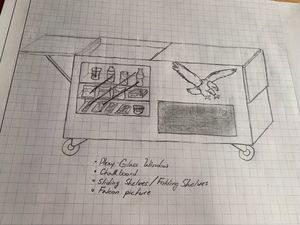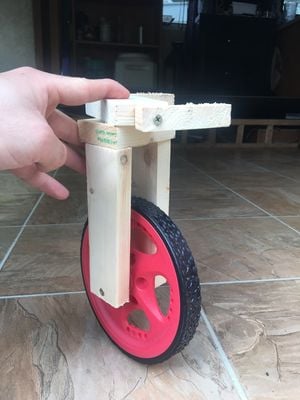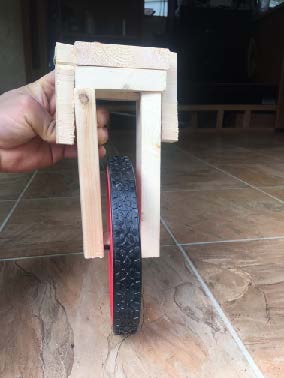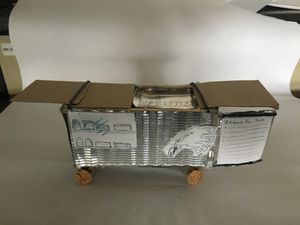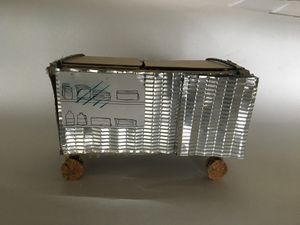Abstract
The goal of this page is to present the design, plans, implementation, maintenance and use of the the concessions cart stand made by group TBD. Background information and understanding of the concession cart project will be covered first, followed by a description of the problem, criteria, and prototyping process. Cost and maintenance will be the last sections of this page.
Background
Zane Middle school is located in Eureka aiming to inspire academic Excellence, Creativity, and the Confidence to Succeed. They provide their students with a number of extracurricular activities like golf, girls volleyball, soccer, basketball, cheerleading, track, and wrestling; an extraordinary After School Program, and these are just a few on a long list. A lot of these activities provide snacks and water. The transportation and storage of this food is where team The Best Designers come in. Closely working with the schools teachers, we set out to design a concessions cart stand that would make the transportation and strife of food easy.
Problem statement and criteria
The issue that Team The Best Designers set out to address was the storage and transportation of snacks and drinks for school events. The school had been previously setting up tables and providing the food from there. The set up and movement of the tables can be a hassle because of the possible strains of lifting or the excess work that comes with setting up an area. With the implementation of a cart, the transportation, set up, and storage of an area that can provide food would be completed can be completed in a few easy steps.
The Criteria was developed by Team TBD and reviewed by the client. The following is a table demonstrates its specifications.
| Criteria | Specification |
|---|---|
| Cost | Must Cost Under $400. |
| Storage | Must be able to fit through doorways 32-36in. |
| Function | Provide optimal amount of storage space for concessions. |
| Durability | Must be able to withstand long term use with children. |
| Maneuverability | Able to traverse tight corners and small spaces. |
| Safety | Must be safe enough to be handled by children. |
Description of final project
Falconstein, is a food concession cart that with help to alleviate to load of food and beverages that the existing cart made by a previous Engineering 215 group. It provides adequate storage capacity for storing food. Utilizing sliding shelves to maximize counter space when in use and easily stored for moving through tight doorways and halls as well as traversing corners. Implementing swivel as well as locking caster wheels to maneuver easily and Place in hard to get areas.
Prototyping
|}
Costs
The cost of this project are demonstrated in two different ways. First is the monetary cost of the project; second is the cost in terms of time.
Cost in Dollars
This First Tables demonstrates a list of item with it's respective cost. The (*)symbol next to an item is to signify that that item was donated and was of no monetary cost to team TBD.
| Materials | Cost of Unit In $ |
|---|---|
| *Plywood (x2) | 50.00 |
| Aluminum Frame Bars (x4) | 22.00 |
| Studs (x6) | 3.33 |
| *Plexiglass | 17.00 |
| Screws (box) | 12.00 |
| *Caster (x4) | 7.99 |
| Pint Can (x2) | 15.00 |
| Painting Materials: Tarp, Brushes, spray paint | 20.00 |
| Total | 318.94 |
Cost in Hours
The diagram bellow demonstrates the cost in hours for team TBD. Between the four group members a total of 244 hours was spent on this project. The sections of the diagram represents a specific phase of design process.
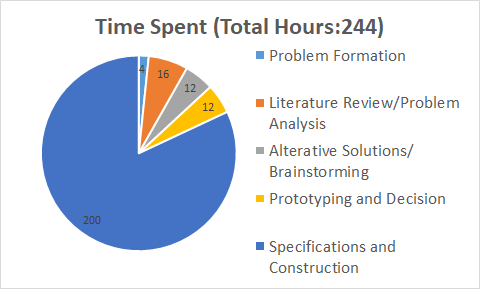
Testing Results
A successful testing of the cart relied on four main factors, safety, maneuverability, appearance, and storage. These factors have the biggest impact on the use of our cart.
Safety was accomplished by through a number of ways. The following steps were taken to assure safety: Assuring there was no loose bolts where in the cart or protruding screws, making the cart bottom heavy so tipping of the cart will be avoided, and assuring cart is capable of withstanding the provided amount of weight.
Maneuverability of the cart worked great. The locking caster wheels in the back of the cart provided controlled "shopping cart" like steering to the concessions cart. when the locks were disengaged, the cart moved freely and could easily be moved in all directions. Locking the caster wheels in a forward direction is recommended when transporting the cart more than a few feet
The final appearance of the cart reflects Zane Middle School's colors and our client's recommendation.
Maintenance
Maintenance on the Falconstein concessions cart is relatively low, only costing about $7.50 per year. This amount is to cover the cost of oiling the caster wheels and occasional paint chipping. This cart is recommenced to be stored indoors to avoid any long term damage to the material (wood/metal) due to rain and ice.
Schedule
- Yearly
- The friction points in the caster wheels will need to be oiled once every year (or whenever necessary). Spraying some WD-40 in the rotating areas of the wheels will help lubricate the the wheels and prevent damage.
- It is recommended that the cart be inspected for paint chipping, or damage every year. Paint minimizes the damage to the exterior of the cart.
Instructions
The use and setup of this cart will have a few easy steps, it was designed to be compact when moving and to expand and create more surface area when set up.
Locking Casters
This cart has four full swivel caster wheels which gives the cart the ability to move in any direction with very little effort from the user. Simply pushing the cart in any direction will cause it to move. The back two wheels of the cart can turn from full swivel to directional locking casters. This is so the cart is easier to move when being transported, giving it maneuverability similar to a shopping cart where the front wheels are free to move in any direction but the back wheels are fixed in a forward direction.
The levers in the two back wheels are yellow to prevent any confusion between the back directional locks and the non painted front brakes (using your foot is most common to apply the the locks))
Brakes
The brakes are designed to keep the cart from moving. This can be accomplished in a very similar way to how the back wheels of the cart are directionally locked.
Slide Out Table
The cart contains a slide out shelf on the right side (when facing the front of the cart). This is made to give the cart more surface area when stationed, allowing for more items to be placed on top of the cart.
Troubleshooting
| Problem | Suggestion |
|---|---|
| Cart is stuck in position and will not move | Make sure brakes (non-painted levers on the left side of the cart when facing it) are in the upmost position. |
| Wheels will not lock in a forward position | Make sure to push the cart forward at least two feet before applying the directional locks. This will insure both wheels are facing in one direction. |
| Slide out shelve is stuck | Lift the slide out shelve from its usual resting area ( this will only be a few centimeters), then push and pull the slide out a few inches in both direction (inside and out). Place the slide out back down. check to make sure slide out table is working properly. |
Discussion and next steps
The Falconstein Cart is a sturdy structure capable of being packed full of drinks and snacks, and transporting them without trouble. It is a spacious cart that will last many years with proper maintenance. Team The Best Designers are proud with the results of this cart and happy to serve the community. The Next Steps are to deliver the cart to Zane Middle School and present the cart to our client.
Suggestions for future changes
Following the maintenance directions will ensure a long lifespan of the Falconstein cart. Replacing screws that will rust if exposed to constant rain will help further the time the Faclonstein cart is functional.
References
https://www.eurekacityschools.org/index.php?option=com_content&view=article&id=50&Itemid=141
HowStuffWorks.com.<https://science.howstuffworks.com/life/genetic/question598.htm> 27 February 2019
Sudiyani, Y., Tsujiyama, S.-I., Imamura, Y., Takahashi, M., Minato, K., and Kajita, H. (1999). “Chemical characteristics of surfaces of hardwood and softwood deteriorated by weathering.” Journal of Wood Science, 45(4), 348–353.
